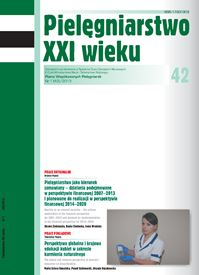The midwife’s professional independence in the opinion of society – condition of fetus
Keywords:
sense of live, values, chronic diseasesAbstract
THE MIDWIFE’S PROFESSIONAL INDEPENDENCE IN THE OPINION OF SOCIETY – CONDITION OF FETUS
Introduction. Normal pregnancy, proper care during pregnancy and delivery enable right physical, emotional and intellectual development of a baby and its health in adult life.
Aim. The aim of the study was an attempt to find out the opinion of the Polish society about midwife’s preparation to independently evaluating the condition of fetus.
Materials and methods. The study was conducted in 2011 by means of the diagnostic survey method applying questionnaire technique. The research tool was a self-constructed questionnaire, which was conducted among 293 women and 212 men who live in the East region of Poland.
Results. The study showed that in respondents’ opinion a midwife is prepared to independently provide health services concerning evaluation of the condition of fetus including periodical listening to the fetal heart rate (82.77%), continuous listening to the fetal heart rate (74.65%), assessing of fetal activity – fetal movement (79.20%), doing CTG (72.47%) and interpreting CTG (55.84). Respondents who took part in the survey were not convicted that a midwife is prepared to independently perform ultrasound examination (38.81%: “rather no” - 23.37%, “definitely no” - 15.45%).
Conclusions. A midwife is prepared to independently provide health services concerning evaluation of the condition of fetus in cluding periodical listening to the fetal heart rate, continuous listening to the fetal heart rate, doing and interpreting CTG, assessing of fetal activity. A mid wife isn’t pre pared to independently perform ultrasound examination.
References
1. Chazan B, Troszyński M. Opieka przedporodowa. [w:] Chazan B, red. Położnictwo w praktyce lekarza rodzinnego. Warszawa: Wydawnictwo Lekarskie PZWL; 1997, s. 67-79.
2. Wielgoś M, Bomba-Opoń D. Zasady opieki ambulatoryjnej w ciąży – rekomendacje Polskiego Towarzystwa Ginekologicznego. Family Medicine & Primary Care Review 2006; 8 (3): 1145-1149.
3. Rozporządzenie Ministra Zdrowia z dnia 7 listopada 2007 r. w sprawie rodzaju i zakresu świadczeń zapobiegawczych, diagnostycznych, leczniczych i rehabilitacyjnych udzielanych przez pielęgniarkę albo położną samodzielnie bez zlecenia lekarskiego (Dz. U. z 2007 r. Nr 210, poz. 1540).
4. Lisowska R. Rola położnej w przygotowaniu ciężarnej do samoobserwacji zmierzających do oceny dobrostanu płodu. [w:] Iwanowicz-Palus G, red. Położnictwo u progu XXI wieku. Materiały z Konferencji Naukowej, Lublin 19-20 marca 1999r., Lublin 1999, s. 244-247.
5. Girzelska J, Mianowana V, Kościołek A, Serafin H. Pomiar w planowaniu opieki położniczej nad ciężarną. Pielęg XXI w. 2011; 4(37): 5-9.
6. McKevitt S, Gillen P, Sinclair M. Midwives’ and doctors’ attitudes towards the use of the cardiotocograph machine. Midwifery 2011; 27: 279-285.
7. Ramowy Program Kursu Specjalistycznego Monitorowanie dobrostanu płodu w czasie ciąży i podczas porodu, http://www.ckppip.edu.pl/index.php?strona=programy_ramowe&podstrona=kursy_specjalistyczne, z dnia 30.09.2012.
8. Ramowy Program Kursu Specjalistycznego Podstawy diagnostyki ultrasonograficznej w położnictwie i ginekologii, http://www.ckppip.edu.pl/index.php?strona=programy_ramowe&podstrona=kursy_specjalistyczne, z dnia 30.09.2012.
9. Sienkiewicz A, Kulesza-Brończyk B, Piekut K. Procedura postępowania podczas badania kardiotokograficznego. [w:] Iwanowicz-Palus G, red. Kobieta i jej rodzina. Profesjonalny poradnik dla położnych. Warszawa: Wydawnictwo Raabe; 2010, Styczeń, s. 54-59.
Downloads
Published
Issue
Section
License
Copyright (c) 2013 Grażyna Iwanowicz-Palus, Ewa Golonka, Agnieszka Bień, Grażyna Stadnicka (Autor)

This work is licensed under a Creative Commons Attribution 4.0 International License.




